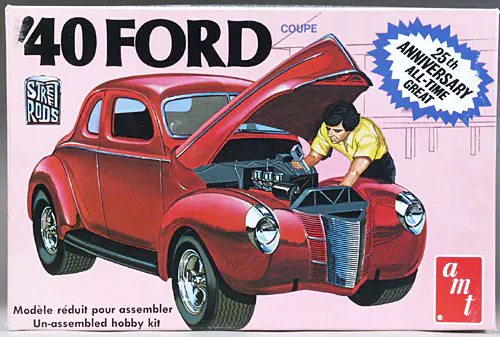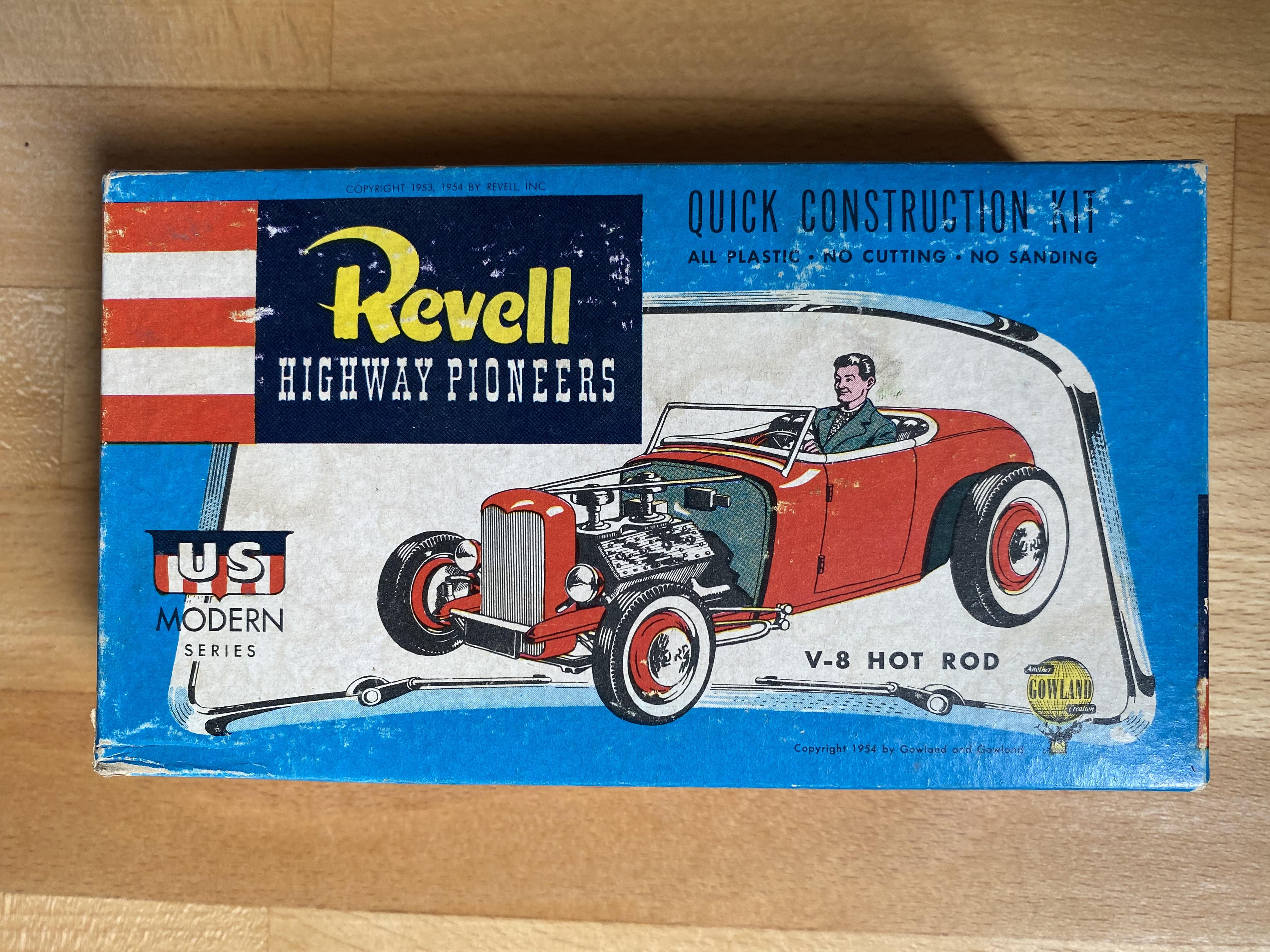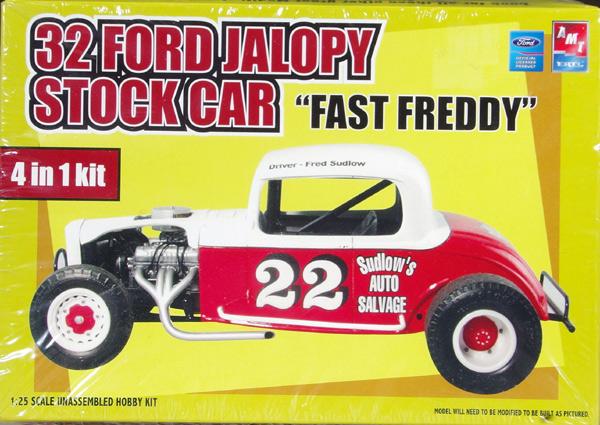-
Posts
327 -
Joined
-
Last visited
Content Type
Profiles
Forums
Events
Gallery
Everything posted by Chris V
-

Revell & Atlantis at the IPMS National Convention 2025
Chris V replied to niteowl7710's topic in Car Kit News & Reviews
Speaking from experience you're better off installing the rear axle/suspension for positive location of the centre of the radius to clear the slicks. On this model I've even replaced the Chevy axle with a modified Olds/Pontiac rear axle out of Revell's "Beatnik Bandit" Showrod: -

AMT, Original hot rod kits, engine options
Chris V replied to Greg Myers's topic in General Automotive Talk (Trucks and Cars)
This other old thread elaborates further on the subject of the old AMT Trophy Series engines: AMT Trophy Series Engines On a related note, only a few of the early AMT kits included hop-up parts for the flathead engines, and only for the 1949-53 generation flatheads. However, the "Street Rods" reissue of AMT's 1940 Ford Coupé included a small additional sprue with a set of finned heads with separate water hoses. For some reason these have never been included in any subsequent reissues of the kit. Though crude by todays' standards they do offer you the option of building a hot rod with a simplistic charm that's very fitting for the old Trophy Series kits. -

Revell & Atlantis at the IPMS National Convention 2025
Chris V replied to niteowl7710's topic in Car Kit News & Reviews
What he said! Straight axle swaps were by no means mandatory back in the day. To improve weight transfer and traction many racers simply swapped the front springs with heavy duty station wagon units in order to raise the front end of the car. On other models like 1949-54 Chevies and C1 Corvettes many fitted spacer blocks between the framerails and front suspension crossmember. -

Revell & Atlantis at the IPMS National Convention 2025
Chris V replied to niteowl7710's topic in Car Kit News & Reviews
Actually the entire chassis is slightly off-center so the interior/trunk floor and wheel houses needs to be trimmed slightly for better alignment and to reduce structural stress on the thin rocker panels when the body is mounted on the chassis. On a side note, it appears that Atlantis is planning to include a plated version of the ex. Revell "Dragster Wheels" Parts Pack in the Chevy. -
I would strongly recommend stripping the previous primer to avoid excessively thick layer buildup and prevent possible paint compatibility issues.
-
The Nailhead valve covers and exhaust headers are from the original issue of the ‘40. Sadly they were later replaced with finned valve covers and some blobtacular exhaust manifolds which somewhat lined up wit the molded-in exhaust system.
-
Jimmy Flintstone offers a ‘51 body with separate bumpers and “bullet”: ‘51 Studebaker
-
Tamiya makes a special paint remover similar to the old Testors “Easy Lift Off”: You brush it on, leave it to work for 5-10 minutes, brush to release the dissolved paint, wipe off with a paper towel, and repeat if necessary. Once all of the paint is gone and the paint remover been thoroughly wiped off, you clean the model with dishwashing detergent and rinse off with water. It even removes some of the most stubborn other types of paint, that brake fluid and lye-based degreasers/cleaning products can’t.
-
Don’t get me wrong: I’m not arguing against a Bulletnose Studebaker - Just stating that there are many other more obvious choices with broader appeal in that subject matter segment . And with no preexisting Disney ties I have a hard time imagining that Round2 will pony up the cash to acquire the licensing for the Muppets franchise just to sell a single kit…
-
At risk of sounding negative that’s not very likely to happen - for the exact same reason we haven’t seen a 1948 Tucker commercially kitted (aside from exclusive small volume aftermarket kits): Though the cars themselves are iconic, the appeal of the subject matter is simply too narrow. There’s virtually no potential for alternate versions to increase return on the tooling investment. No significant body style variations, commercial applications, modification-, movie- or racing history. Unlike the ‘50 Oldsmobile (which was based on a Racing Champions coin bank modified with parts from AMT’s 1951 Chevrolet Bel Air) no images of an actual model was used, when the box art for the “upcoming” Studebaker kit was announced in the early 00’s. To this day I don’t think it’s ever been confirmed, that development of an actual model kit had progressed beyond the preliminary box art design to gauge the customer demand.
-
Yes: The Street Machine is based on the same tooling but can’t be built stock. It does however come with a Big Block/Automatic transmission and some beautifully detailed Cragar “Street Star” Wheels. In my humble opinion the “Mueller Era” ‘57 Bel Air Street Machine would have been far more appealing with the wheel/tire combo from the Corvette Street Machine.
-

1972 Challenger parts needed!
Chris V replied to usmc_vette1984's topic in Model Building Questions and Answers
The ARII Challenger is essentially a seventies’ toy. There’s no point in trying to detail it further. Despite being advertised as 1:24 scale just about nothing from the ex. Monogram 1:24 1970 Challenger T/A kit will fit without extensive modification. Your best bet is to find a decent MPC 1972 Dodge Challenger rebuilder, and detail it with parts sourced from AMT’s 1970 R/T and Revell’s 1970 ‘Cuda. -
You'll find there are about as many opinions as people to respond: Essentially it's mostly a matter of personal preferences. It's important to remember that the larger makes have been around for many decades, and thus their tooling archives reflect the technical advancements and changing consumer preferences throughout history. Furthermore there's no definitive correlation between the age of the tooling and quality of the model: Some models dating back to the early sixties are amazingly enjoyable to build and feature an impressive level of detail, while others are crude and toylike with the added risk of worn or damaged tooling. However, even newly tooled kits can be somewhat simplified and suffer from poorly fitting parts and accuracy issues, bodywork proportions being one of the most commonly noted issues. As a glutton for punishment I sometimes opt to base my builds on kits known to have certain issues or shortcomings - just to prove a point that they can in fact be built into nice models.
-
My vote is for the following: - The finned 2- and 3- carb fuel distribution blocks - The Halibrand QC conversion with Model A rear crossmember and leaf spring for Revell's line of '32 Fords (perhaps as a double set like the conversion for Revell's new Model A kits) - The Olds Rocket and Ford Y-Block Hop-Up kits (the separate items were beautiful but disproportionally expensive due to Shapeways' pricing structure)
-
But it has… 3DScale Parts offers the rollbar, header and steering wheel package for the “Big Drag”. The biggest issue seems to be chrome plating the 3D printed items.
-

DTR/AMT 1932 Ford Jalopy kits
Chris V replied to Chris V's topic in Model Building Questions and Answers
No they don’t… I snagged the 5W as soon as it was confirmed that it is in fact molded in white 😜 Just like Bill @Ace-Garageguy and several other responders I like to build traditional Hot Rods with an old timey flavor: I found that by lopping the front frame horns off of an AMT ‘32 Phaeton/Vicky Chassis and cutting the front frame off of an AMT ‘32 5W/Roadster just behind the crossmember, you can graft the framerail pieces together with the Phaeton/Vicky chassis to achieve a more accurately proportioned ‘32 Chassis. This can then be further enhanced by adding the caractherisic upswept sidewall stamping detail and a rear crossmember and spring from AMT’s ‘29 Model A Roadster. I’m not too concerned about the funky body proportions of AMT’s ‘32 Fords, though: Since the frames are already slightly narrowed at the at the rear, they’re ideal for a Model A body-swap - Which is exactly what I’m planning! -

1971 DOHC 426 HEMI CUDA (?)
Chris V replied to TECHMAN's topic in General Automotive Talk (Trucks and Cars)
Though the car has obviously been extensively modified, I just have to point out that this is not a 1971 Barracuda/'Cuda but a 1972-74 model - the most obvious giveaways being the square side marker lights (The 1970-71 models had countersunk oblong lenses) and the squarish headlight surrounds (The 1971 models had dual headlights as a one year only design feature). It appears to have been fitted with modern aftermarket heads. As @Mark stated above, the real experimental DOHC "Doomsday Machine" supposedly never ran under its own power. Nice and clean build! -

DTR/AMT 1932 Ford Jalopy kits
Chris V replied to Chris V's topic in Model Building Questions and Answers
I think the last reissue of the AMT 1932 5-Window Coupé was around 2010. It may have something to do with Revell's release of their newly tooled 5 Window Coupé in 2011. To the best of my knowledge the AMT 1932 Roadster was last reissued as part of the "Pro Shop"-series back in 1998. There's no disputing that Revell's series of '32 Fords are miles ahead of the outdated early sixties tooling from AMT. Despite their shortcomings the old AMT kits have a certain nostalgic appeal, and are surprisingly enjoyable to build - especially since they offer the same degree of parts-interchangeability as the modern Revell kits. On previous occasions I've argued, that the entire series of AMT 32 kits could be revitalized simply by adding classic hot rod tires and a small "universal" sprue with a few carefully selected upgrades including: a better looking dropped front axle, a dropped headlight bar, 1939 Ford/1950 Pontiac taillights, and perhaps a set of finned heads/dual carb intake for the flathead. -

Aftermkt exterior door handles for Mopars Who ?
Chris V replied to gtx6970's topic in Car Aftermarket / Resin / 3D Printed
Fireball Modelworks does - Worth every penny! -

DTR/AMT 1932 Ford Jalopy kits
Chris V replied to Chris V's topic in Model Building Questions and Answers
It was indeed a dark time under the previous-ownership, before Round2 took over and turned things around. I think, the worst case I've ever seen was the "Buyers Choice" reissue of MPC's 1969 Dodge Charger 500, issued around the millennium: The box art car had obviously been kitbashed from parts from AMT's 1969 Plymouth GTX and wheels of unknown origin. -

DTR/AMT 1932 Ford Jalopy kits
Chris V replied to Chris V's topic in Model Building Questions and Answers
Thanks - that gave me exactly the information I was looking for! My mistake not checking Ebay-listings before asking... -
On a side note: If you want to build it as a '40 you may want to grab one of Drag City Castings resin '40 Ford Deluxe Hoods while they're still available. Over the years part the molds for both the 1940 Coupé and 1939-40 Sedan have become very worn, most notably the hoods for both kits. Drag City Casting made a mold from the hood from a mint first-issue kit with the side detail intact - A vast improvement over most the hoods included in most reissues since the seventies. Like most other kits, the tooling for the Sedan kit was also modified over the years. At some point the original plated headers for the optional Oldsmobile engine were replaced with some ill-fitting new headers, which appear to have been sourced from an early 1970's AMT Chevrolet Camaro kit. However in AMT's 1928 Ford Sedan you'll find an extra set of headers for the optional Chrysler engine, that bear a striking resemblance to the headers originally included in the 1939/40 Sedan, and thus are a drop-in fit for the Oldsmobile engine.
-
Back in the late 00's "Dirtrack Racecars" commissioned AMT to do a series of "Jalopy" themed kits from their range of 1932 Ford tooling. The kits were criticized for their misleading boxart featuring extensively rebuilt models with numerous parts not included in the kit. However I was wondering if anyone can tell me, if this particular version of the 5-Window Coupé is molded in grey or white styrene? (It might sound utterly ridiculous, but the plastic color is actually important for a vintage themed kitbash-project I'm currently contemplating)
-

Are all AMT 1933 Willys based on the same kit?
Chris V replied to LDO's topic in Model Building Questions and Answers
The rear axle is a somewhat simplified 1957-64 Oldsmobile/Pontiac unit. The best source by far is AMT’s 1962 Pontiac Catalina.






